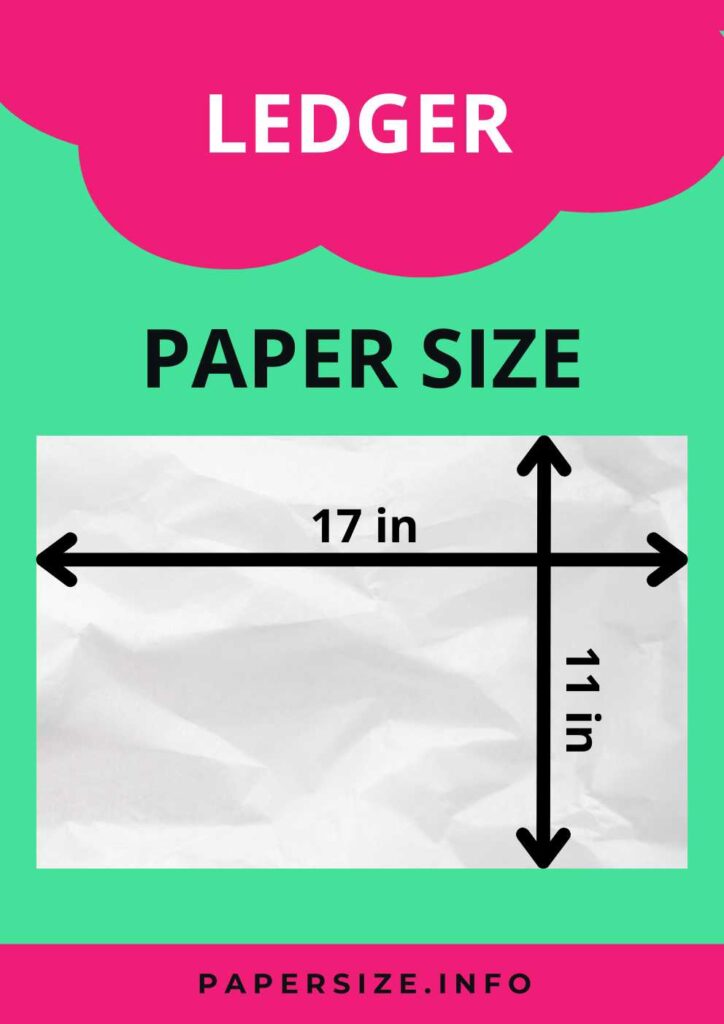Ledger Paper Size and Dimensions

Ledger paper size, Ledger sheet size, Ledger paper size in mm, cm, meter, inches and feet. Finally all Ledger paper size data in one place.
The Ledger paper size, also known as Tabloid, is a paper format that is not part of the international standard sizes recognized by ISO. It is primarily used in the United States and several other countries, catering to specific needs in these regions.
Dimensions of Ledger Paper Size
- Ledger paper size in millimeters: 279.4 mm x 431.8 mm.
- Ledger paper size in centimeters: 27.94 cm x 43.18 cm.
- Ledger paper size in inches: 11 by 17 inches.
This size is particularly useful for applications that require a larger area than what is provided by standard sizes like Letter or Legal. It is frequently utilized for printing newspapers, making large-scale diagrams, business spreadsheets, and comprehensive architectural plans where additional space is necessary to effectively display wider content.
The preference for Ledger size in certain parts of the U.S. and other countries stems from its practicality in various professional settings, including engineering, advertising, and graphic design. It allows for the presentation of bigger and more detailed visuals and information, which are crucial in these fields.
Despite its utility, the non-standard status of Ledger paper size means it is less commonly available globally, which can pose challenges for international businesses and professionals working across borders. Documents and materials prepared on Ledger size paper might require resizing or formatting adjustments when being shared with international partners or clients who use the ISO standard sizes like A3 or A4.
Furthermore, the use of Ledger size affects the compatibility with standard office equipment and supplies, such as printers and filing systems, which are often designed to accommodate the more common A4 or Letter sizes. Users often need to ensure their equipment can handle Ledger size to avoid operational issues.
Area of One Sheet of Ledger Paper
Understanding the area covered by a single sheet of Ledger paper can be incredibly useful in various professional contexts, despite its dimensions not being derived from the area itself. Knowing this area is valuable for tasks such as graphic design, printing layouts, and even in real estate or advertising where large visual presentations are necessary.
Area Measurements of Ledger Paper:
- Square Meters: Approximately 0.1206 sq m
- Square Inches: 187 sq in
- Square Feet: 1.2986 sq ft
These measurements indicate that Ledger paper offers a considerable amount of surface area, making it suitable for printing larger documents that require more space than typical Letter or Legal sizes. This can include large-scale charts, architectural plans, or comprehensive tables that benefit from a broader layout to enhance readability and detail.
The larger size of Ledger paper is particularly favored in industries such as engineering, architecture, and graphic design, where the ability to print on a larger scale directly supports the clarity and impact of visual presentations. It is also popular for creating newspapers and large advertisements, where the extra space can be effectively utilized for a more engaging display.
In practical terms, knowing the exact area of Ledger paper helps in planning the usage of ink and paper more efficiently, managing costs, and ensuring environmental considerations are met by reducing waste. For instance, understanding the area helps in calculating how many prints can be made per roll of paper in large-format printing operations.
Moreover, for international communications, having an understanding of Ledger size in terms of square footage or square meters can aid in translating these dimensions into internationally recognized formats, ensuring compatibility with global standards and practices.
Ledger Size In Pixels
The conversion of Ledger paper size to pixels is a common topic of inquiry, especially when there’s a need to print a design with precise detail on Ledger-sized paper. The actual measurement in pixels varies based on the resolution of the device you are using, whether it’s a screen or a printer.
Understanding DPI (Dots Per Inch):
DPI stands for dots per inch, a measure that directly correlates to the pixel density of a digital image on physical surfaces. The native screen resolution often ranges between 100 and 120 DPI, contrary to the outdated belief that standard monitor resolution is 72 DPI. Printers typically have higher DPI settings, with home or office printers usually operating around 300 DPI. For professional printing services, the DPI can range from 250 to 600, though some high-end printers may reach up to 1200 DPI for ultra-high-quality outputs.
Pixel Dimensions of Ledger Paper at Various DPI Settings:
- 96 DPI: 1056 x 1632 pixels
- 100 DPI: 1100 x 1700 pixels
- 120 DPI: 1320 x 2040 pixels
- 300 DPI: 3300 x 5100 pixels
- 600 DPI: 6600 x 10200 pixels
These values represent how many pixels will constitute the width and height of a design intended for printing on Ledger-sized paper, ensuring that the printed output matches the digital design without distortion.
Why Knowing Your DPI Is Crucial:
Choosing the correct DPI setting is essential for achieving the desired clarity and detail in your printed designs. A higher DPI results in a more detailed and clear image but also means a larger file size, which could impact printing speeds and costs. It’s important to align your design with the capabilities of your printing device to ensure optimal results.
Practical Considerations:
Before beginning a design project intended for Ledger paper, verify the DPI settings of the intended printing device. Knowing the exact DPI allows you to create a design with the appropriate number of pixels, ensuring the dimensions of your digital image perfectly match the physical dimensions of Ledger paper, thus avoiding any issues such as image stretch or pixelation.

